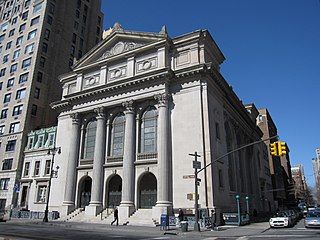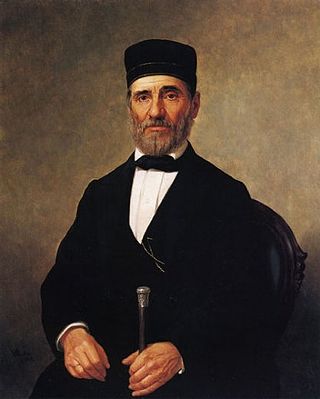
The Touro Synagogue or Congregation Jeshuat Israel is a synagogue built in 1763 in Newport, Rhode Island. It is the oldest synagogue building still standing in the United States, the only surviving synagogue building in the U.S. dating to the colonial era, and the oldest surviving Jewish synagogue building in North America. In 1946, it was declared a National Historic Site.

Bevis Marks Synagogue, officially Qahal Kadosh Sha'ar ha-Shamayim, is an Orthodox Jewish congregation and synagogue, located off Bevis Marks, Aldgate, in the City of London, England, in the United Kingdom. The congregation is affiliated to London's historic Spanish and Portuguese Jewish community and worships in the Sephardic rite.
The National Council of Young Israel (NCYI) or Young Israel, is a synagogue-based Orthodox Judaism organization in the United States with a network of affiliated "Young Israel" synagogues. Young Israel was founded in 1912, in its earliest form, by a group of 15 young Jews on the Lower East Side of Manhattan. Their goal was to make Orthodox Judaism more relevant to young Americanized Jews at a time when a significant Jewish education was rare, and most Orthodox institutions were Yiddish-speaking and oriented to an older, European Jewish demographic.

Judah Touro was an American businessman and philanthropist.

Touro Synagogue is a Reform Jewish synagogue located at 4238 St. Charles Avenue, in Uptown New Orleans Louisiana. It was named after Judah Touro, the son of Isaac Touro, the namesake of the country's oldest synagogue, Touro Synagogue in Newport, Rhode Island. The New Orleans Touro Synagogue is one of the oldest synagogues in the United States and the oldest in the country outside the original Thirteen Colonies.

Isaac Touro was a Dutch-born American rabbi. He was a Jewish leader in colonial America. Born in Amsterdam, in 1758 he left for Jamaica. In 1760, he arrived in Newport, Rhode Island, to serve as hazzan and spiritual leader of Jeshuath Israel, a Portuguese Sephardic congregation. Soon after his arrival, the congregation built the Touro Synagogue, which is the oldest synagogue in the United States.

Congregation Mikveh Israel, is a Sephardic Orthodox Jewish synagogue located at 44 North Fourth Street in Philadelphia, Pennsylvania, in the United States. The congregation traces its history from 1740. Mikveh Israel is a Spanish and Portuguese congregation that follows the rite of the Amsterdam esnoga. It is the oldest synagogue in Philadelphia, and the longest running in the United States.

The Congregation Shearith Israel, often called The Spanish and Portuguese Synagogue, is an Orthodox Jewish synagogue located at 2 West 70th Street, at Central Park West, on the Upper West Side of Manhattan in New York City, New York, United States.

Henry Pereira Mendes, was an American rabbi who was born in Birmingham, England and died in New York City. He was also known as Haim Pereira Mendes.

Alexander Hart was a major in the Confederate Army during the American Civil War.
Manis (Morris) Jacobs was the founder, first president and although unordained, the first rabbi of Congregation Shangarai Chasset of New Orleans.
Hermann Kohlmeyer was an American rabbi in charge of Congregation Shangarai Chasset in New Orleans, Louisiana.
James Koppel Gutheim was the rabbi of Congregation Shangarai Chasset of New Orleans.

Rabbi Dr. Bernard Illowy was a rabbi and leader of Orthodox Judaism in the United States.
Isaac Leucht was a Reform Rabbi and communal leader in New Orleans. He was the last rabbi of Congregation Shangarai Chasset before it merged with Congregation Nefutzot Yehudah to become what is now the Touro Synagogue.

The Gardens Shul, formally, the Cape Town Hebrew Congregation (CTHC) is a Modern Orthodox synagogue located in the Company Gardens, in the Gardens neighborhood of Cape Town. It has the oldest Jewish congregation in South Africa, dating to 1841. The congregation, known as "The Mother Synagogue of South Africa," possesses two historic structures, the 1863 synagogue known as the Old Shul and the 1905 synagogue. The South African Jewish Museum, located in its grounds, also occupies the Old Shul and is responsible for its upkeep. The 1905 building is an example of Edwardian architecture and has been called "one of the most magnificent synagogues in the world."
Congregation Shaare Zion is an Orthodox Jewish Sephardic synagogue located at 2030 Ocean Parkway in Brooklyn, New York City, New York, United States.

Sephardic Bikur Holim Congregation (SBH) is an Orthodox Jewish congregation and synagogue in the Seward Park neighborhood of Seattle, Washington, in the United States, that practices in the Sephardic tradition.
Ilan Daniel Feldman is an American Orthodox Jewish rabbi, public speaker and author. Since 1991 he has been the senior rabbi and spiritual leader of Congregation Beth Jacob of Atlanta, Georgia, succeeding his father, Rabbi Dr. Emanuel Feldman, who founded and led the congregation for 39 years. Over the past 20 years Feldman has built on his father's work, bringing a community kollel to the city and nurturing the growth of Atlanta as one of the leading centers for Orthodox Jewish life in America. He is also a founding board member of the Association for Jewish Outreach Programs (AJOP).











